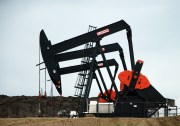A slow-motion disaster has been unfolding for months at an oilsands extraction site in Cold Lake, Alberta, a few hours north of Edmonton. Provincial authorities and media reports have called it a series of “releases” or “spills”, but a more accurate description would be an uncontrolled blowout in the oilsands reservoir deep underground.
According to the Alberta Energy Regulator (AER), that blowout has caused roughly 5,975 barrels of bitumen to surface at the Primrose and Wolf Lake facility, killing wildlife and contaminating groundwater aquifers, soil, vegetation and a nearby water body. As of July 27, the regulator has indicated the incident is ongoing.
In addition to the environmental impacts, this blowout has the potential to make or mar the reputation of the province’s fledgling regulator, which has been promoted as a symbol of Alberta’s commitment to transparent and rigorous enforcement of environmental standards. How the province handles this situation will help to determine how the AER is perceived by industry, Albertans and our customers beyond our borders.
Lack of public disclosure
The latest incident is the fourth that has occurred since May 20 at the Primrose and Wolf Lake in situ oilsands site, operated by Canadian Natural Resources Limited (CNRL). This latest incident started on June 24 and was in an emergency stage until July 17, but information about the cumulative volume of bitumen released at the site was not made public until July 29. Even last week the province was significantly underreporting the size of the release and the area impacted relative to internal company documents that showed the cumulative spill volume to have reached thousands of barrels of bitumen, compared to just 176 barrels as reported by the AER.
 CNRL has disclosed virtually nothing about the blowout to the public. The only reference to the incident was made in a one-page statement issued on July 25 after several days of consecutive media coverage of the incident.
CNRL has disclosed virtually nothing about the blowout to the public. The only reference to the incident was made in a one-page statement issued on July 25 after several days of consecutive media coverage of the incident.
The company says it immediately reported the incident to the AER, but the regulator delayed making the blowout public until June 27, when it released a statement indicating it had ordered CNRL to stop injecting high-pressure steam into the underground bitumen deposits.
It was the third time the province had given such an order at this site, with the first dating back to 2009. Since the company has transitioned from the steaming phase to the production phase, it is not clear that this order has had any benefit to the environment.
What went wrong
It’s not yet apparent what caused the blowout, or any of the previous incidents at the in situ facility.
Roughly 35 per cent of all in situ production uses a technique called High Pressure Cyclic Steam Stimulation (HPCSS), which cycles between two phases: first, steam is injected into an underground oilsands deposit to soften the bitumen; then, the resulting hot mixture of bitumen and steam (called a “bitumen emulsion”) is pumped up to the surface. The process is then repeated multiple times.
It appears the CNRL Primrose and Wolf Lake facility was near the end of the steam injection phase (the time when pressure in the formation is highest) when the blowout occurred. Cracks oozing at the surface indicate that bitumen emulsion has burst through the cap rock and travelled approximately 500 metres before reaching the surface of the ground. The exact route the emulsion followed as it pushed its way to the surface is currently unknown.
CNRL has yet to state whether or not bitumen emulsion continues to flow from the pressurized formation, or whether it has relieved the pressure to protect groundwater and the surface from further impact. CNRL maintains that production will continue as usual at the site.
The design of HPCSS projects is geared towards maximizing bitumen production by maximizing the pressure injected into the formation, up to a level that is deemed safe by both the company’s engineers and Alberta’s regulatory authorities.
Blowouts of this manner represent a fundamental failure in the design and integrity of this project.
Not the first time
CNRL had a similar blowout occur in January 2009, which saw 5,686 barrels of bitumen recovered from the surface. The Energy and Resources Conservation Board (or ERCB, the predecessor to the AER) investigated, using steam injection tests to determine how the blowout occurred. However, the results were inconclusive leaving the ERCB to speculate on how the bitumen emulsion made its way to the surface.
Following this investigation, the ERCB restricted the volume of steam CNRL could inject per cycle, but ultimately determined that HPCSS operations could continue safely.
This latest incident calls that decision into question. Even one blowout would be unacceptable — but four blowouts signify a complete failure in the project design and approval.
First test of the new regulator
Expectations are high for the new single regulator, as the Government of Alberta has promised a more transparent and proactive approach to regulating energy projects.
The CNRL Primrose project will be a test for the AER. Stakeholders and the public will be able to compare and contrast the response of the AER to this recent incident to the response of its predecessor organization, the ERCB, when it decided to uphold the Primrose approval after the 2009 incident.
CNRL has placed the full burden of public disclosure and transparency on the AER by maintaining near silence about the failed project. This shifts the spotlight to how the AER will handle its responsibility to be accountable to the public in these types of cases.
To its credit, the AER recently launched an online public incident reporting archive, containing up-to-date information on events related to energy development, such as pipeline spills, well releases, and impacts to water bodies. Unfortunately, this database only includes two months’ worth of reports — meaning reports from earlier incidents at CNRL appear at this time to be no longer publicly available.
Many questions remain
Many questions remain to be answered about this incident and the implications it may have for similar projects in the future.
The systemic nature of these failures points to a potential design failure and calls into question the project’s approval. It remains to be seen whether the process to review the approval will be transparent and whether it will have any significant consequences for the future of this project.
The blowouts have introduced a bitumen emulsion into groundwater-bearing zones. It’s critical to understand how extensive the contamination is, what can be done to remediate groundwater contaminated with bitumen, and how long the area will require maintenance as a contaminated site.
Looking forward, the CNRL blowouts are an important a test case for the AER. It’s also an opportunity to chart a new course for Alberta’s regulatory regime, by taking a more proactive approach in public disclosure of environmental problems in the oilsands and by demonstrating that regulatory approvals will be withdrawn if necessary to protect the environment.
As bitumen continues seeping to the surface at the CNRL site, it won’t take Albertans long to make up their minds about whether the move to a single regulator represents a change for the better, or simply a change.











